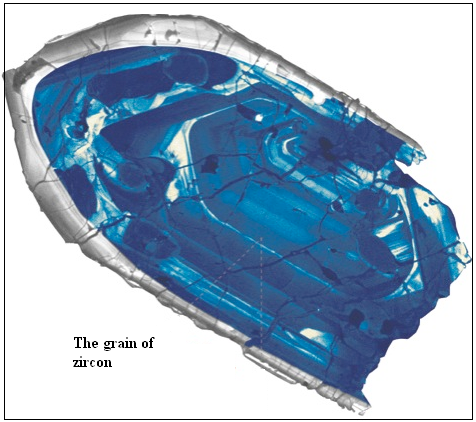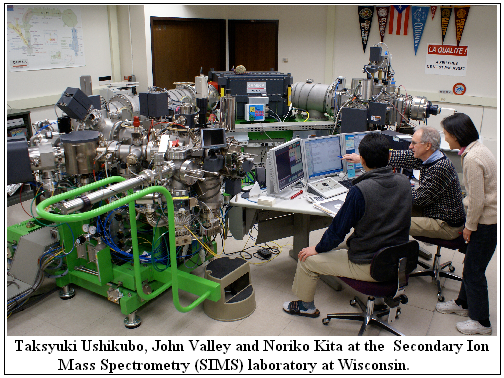Doubts about a classic time keeper used in geology have been laid to rest, says S.Ananthanarayanan.
Assessing the antiquity of the very ancient earth calls for finding things that were around at that far off time. Most rock or minerals which are on hand now were formed later on or have changed and corroded, to be of no use in counting the years. The extremely hardy mineral, zircon, is an exception, and, as it contains traces of radioactive uranium and thorium, which decay into two forms of the lead, it has been possible to date samples as far back as 4.4 billion years ago.
But this same feature of radioactivity ravages the crystal structure of zircon and leads to migration of decay products, which has raised questions about how reliable date assessment based on zircon crystals can be. John W. Valley, Aaron J. Cavosie, Takayuki Ushikubo, David A. Reinhard, Daniel F. Lawrence David J. Larson, Peter H. Clifton, Thomas F. Kelly, Simon A.Wilde, Desmond E. Moser and Michael J. Spicuzza, of Wisconsin, Puerto Rico, Perth in Australia and Ontario in Canada report in the journal, Nature Geoscience, that their detailed study of radioactive effects on zircon crystal structure shows that the mobility of lead atoms in the oldest samples is too little to affect the accuracy of age assessment.

Zircon
Zircon is a mineral composed of atoms of the element zirconium, combined with silicon and oxygen, forming part of a group of compounds that are formed with the silicate group, which form nearly 90% of the earth’s crust. Zircon occurs in most kinds of rock in the form of tiny crystals. Zircon is hard and chemically inert and persists unchanged in form in most occurrences of sand and is a common trace constituent in hard rock.
Uranium and thorium atoms often find a place in the crystal structure of zircon, but the element lead is positively rejected. This is a useful feature because uranium and thorium atoms are radioactive and decay, after some steps, into forms of lead. The levels of uranium or thorium and lead, in a sample, can thus indicate the age of the sample since it was formed. The ratio of the different forms of lead that are found in the sample can also indicate the age. And the fact that lead cannot enter the zircon crystal except by being formed in situ through radioactivity makes sure that the levels of lead measured have actually arisen from radioactivity.
The uranium (U) nucleus exists in two forms and their decay leads to different final forms of lead (Pb). One starting form is 238U, or uranium with 238 massive particles in the nucleus, and this decays, with the emission, in steps, of 32 massive particles, to 206Pb, or lead with 206 massive particles in the nucleus. The other form, 235U, decays, with emission of 28 massive particles, to 207Pb. In the case of thorium, it is 232Th that decays, through ten steps, to 208Pb. Now, the emission of all these massive particles, usually in groups of 4 particles, called an alpha particle, result in powerful alpha particle projectiles and also strong recoil of the emitting nuclei. This is the activity that jostles the zircon crystal structure and in time, the crystals could break down to amorphous, or shapeless entities. While the studies conducted are on intact crystals of zircon, the mechanism of conversion of U or Th to Pb, and some features of the variation in levels of residual isotopes found, with ambiguous age estimates, have suggested that there is loss of lead atoms from the samples and this has gravely affected the credibility of the assessment as a means of age determination.
Accurate determination of the age of formation of the earth’s crust and the timing of the impact event that is credited with the formation of the moon, are of importance for the understanding of the origins of the internals and the surface of the earth and the moon, and their evolution. Apart from Pb levels, the levels of isotopes of oxygen in zircons also provides a peephole to the quality of oxygen in primordial atmospheres and hence the pace of evolution of life. In the context, uncertainty of the reliability of the U-Th-Pb survey in zircon, which is the only method available for age assessment in the 4 billion-year range, affects a series of conclusions.
Lead atom migration
Although serious questions have been raised based on the possibility of migration of lead atoms as a result of radiation, John Valley and others note in their paper that the matter has not been studied so far at the atom-atom scale and the relation of radiation damage to Pb migration is poorly understood. The group therefore worked on a sample particle of zircon, derived from pre-existing rock, in the Jack Hills, western Australia and used the methods of atom probe tomography (APT), which is to look into the layers of a material by analysis of the kind of atoms the material gives off as it is etched or evaporated, using an electric field, by scanning electron microscopy (SEM), where a surface is scanned atom by atom by a beam of electrons, which get scattered at the surface, and by secondary ion mass spectroscopy (SIMS), where secondary emission from the surface is analysed.

Using these hyper-sensitive methods, the group reached into the core layer of the particle of rock, the interior, which revealed its most ancient age of 4.382 billion years. The outer layers showed an age of about 3.4 billion years, or later growth, at higher temperatures, for which there is geological evidence in the Jack Hills region. And the oldest rock at the core was analysed, using APT and SIMS, to reveal that there had been clear radiation damage, with movement and concentration of lead atoms into clusters, creating peaks and lows in the levels recorded, at a fine scale.

But detailed study has been able to show that the movement of lead atoms was through short distances andthere has been no leakage of lead atoms in the clusters forced by radiation effects. The clustering, or non-uniformity was also at the fine scale and did not affect measurements using methods like SIMS, which cover many clusters. The group has described the mechanism leading to anomalous results earlier reported and with examination of 409 of the clusters formed, has made a precise assessment of age of one of the grains of rock, at 3.374 billion years, with an uncertainty of only 6 million years. A conclusion drawn is that a sea of molten rock that covered much of the earth was before formation of the crust and the samples of zircon, and soon after the formation of the earth. The result then constrains the uncertainties in models of how the earth and the moon may have formed. Apart from clearing doubts about the reliability of zircon-based age assessment, the precise methods that have worked with the Jack Hills zircon can now be used with zircon derived from meteorites or lunar samples., for further understanding.

' ------------------------------------------------------------------------------------------